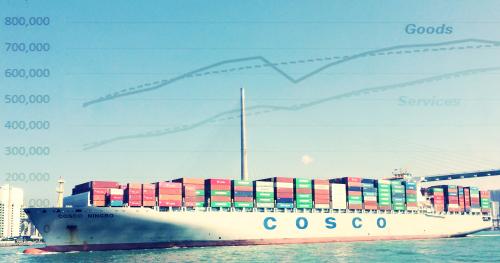The Trump administration’s trade policy took another abrupt turn last week with a spontaneous announcement to impose tariffs of 25 percent on steel and 10 percent on aluminum. The tariff declarations represent the latest in a line of aggressive trade policy changes, beginning with the removal of the United States from the Trans-Pacific Partnership and the renegotiation of NAFTA.
In a country as large and economically diverse as the United States, these macro policy shocks have local consequences and, once again, America’s local and state economic officials are asking how this latest trade policy shift will influence their own economies.
At least three scenarios are possible for U.S. regional and state economies. The argument in favor of the tariffs is that they are a counterweight against foreign producers of aluminum and steel that have flooded the U.S. market, putting American companies at a disadvantage. And for those metro areas and states that concentrate steel and aluminum production, this may represent a welcome relief.
However, the decision may put regions and states at an economic disadvantage, in at least two additional ways.
The first mechanism is via retaliatory tariffs from other countries on key American export industries. While it is unclear whether other countries will respond with their own retaliatory measures, Canada, China, and the European Union (EU) have signaled that they will respond by increasing tariffs on American-made products, potentially curbing exports. It is still too early to tell whether Trump’s move will result in a larger scale trade war, but changing the export competitiveness in particular products and industries will come to ground differently based on the unique export strengths of cities, regions, and states. The EU has already identified three iconic American products—bourbon, blue jeans, and motorcycles. Interestingly all implicate the states of key congressional leaders.
The second mechanism is through the ripple effects of higher prices for steel and aluminum imports, two critical inputs for industries as diverse as auto manufacturing, brewing, and construction. Using U.S. Census Bureau data on imports, we can examine how higher tariffs on aluminum and steel will implicate state economies that rely on those materials to support their key industries.
In 2017, imports of steel and aluminum goods covered within the scope of the U.S. Commerce Department’s Section 232 investigation totaled nearly $48 billion, or about 2 percent of total U.S. imports. Steel imports were a little over $29 billion while aluminum flows were about $19 billion.
When measured by total volume, the nation’s largest states dominate steel and aluminum imports. Texas, California, Illinois, Michigan, Louisiana, Pennsylvania, Ohio, and New York all import more than $2 billion annually in steel and aluminum products, together accounting for 60 percent of the nation’s total. Aside from Texas, California, and Louisiana, these states concentrate in the Northeast and Midwest’s Rust Belt. Given the large size of their economies, disruptions to trade in these states have significant potential to influence national economic growth and key industry sectors like automotive manufacturing, chemicals, and oil and gas production.
However, some states’ production relies more on steel and aluminum, measured by the share of those products that account for total imports. The figure below ranks states based on this metric.

The states that rely most on steel and aluminum imports as a share of their total import base cut an interesting economic geography. In Missouri, Louisiana, Connecticut, and Maryland, aluminum and steel imports account for at least 5 percent of total state imports, double the share of the nation’s 2 percent total.
Louisiana presents a particularly notable example. Oil and gas drillers and petrochemical producers in that state rely on imported steel and aluminum to support their operations. The Port of New Orleans imported 2.48 million tons of steel in 2017, accounting for 30 percent of its tonnage.
Maryland’s imports are also disproportionately weighted towards aluminum and steel. As the Baltimore Sun reported, Maryland manufacturers of steel products are concerned that they will be put at a disadvantage, both due to higher input costs and by potentially limiting their access to important export markets should retaliatory measures be put in place.
The impact of these tariffs on the U.S economy would be the strongest if Trump’s Monday tweet signals the inclusion of NAFTA. Canada and Mexico supply together 32 percent of U.S aluminum and steel imports. Canada alone accounts for one-fourth of U.S imports in these commodities.
We have large trade deficits with Mexico and Canada. NAFTA, which is under renegotiation right now, has been a bad deal for U.S.A. Massive relocation of companies & jobs. Tariffs on Steel and Aluminum will only come off if new & fair NAFTA agreement is signed. Also, Canada must..
— Donald J. Trump (@realDonaldTrump) March 5, 2018
The inclusion of NAFTA in the tariffs would be particularly hard for state economies most dependent on Canada and Mexico. Michigan, for instance, relies on NAFTA for more than 70 percent of its steel and aluminum products. These imports support the state’s automotive and metalworking clusters, which together employ 230,000 workers.

But even if Canada and Mexico were spared, the tariffs would still apply to other strategic partners of individual U.S states. Illinois, the nation’s second largest importer of steel products, imports 41 percent of its steel from Brazil. Illinois also imports 29 percent of its aluminum from China, as aluminum is increasingly used as a substitute for steel in the U.S auto industry.
These proposed tariffs are unlikely to achieve their intended goals of pressuring trade partners suspected of creating market distortions from subsidies and dumping. Instead, they are increasing uncertainty over the coherence of America’s trade strategy and antagonizing its trade partners. At minimum, these tariffs will disrupt those firms, industries, regions, and states that rely on steel and aluminum imports, which at this point is still a relatively small segment of U.S. trade. However, if trade partners respond with their own retaliatory tariffs on a broader set of export industries, exposure to the latest Trump trade shock will spread.
Details on volume and concentration of steel and aluminum imports by state available in this appendix.







Commentary
How Trump’s steel and aluminum tariffs could affect state economies
March 6, 2018